Metal ions in aqueous solution
A metal ion in aqueous solution or aqua ion is a cation, dissolved in water, of chemical formula [M(H2O)n]z+. The solvation number, n, determined by a variety of experimental methods is 4 for Li+ and Be2+ and 6 for elements in periods 3 and 4 of the periodic table. Lanthanide and actinide aqua ions have a solvation number of 8 or 9. The strength of the bonds between the metal ion and water molecules in the primary solvation shell increases with the electrical charge, z, on the metal ion and decreases as its ionic radius, r, increases. Aqua ions are subject to hydrolysis. The logarithm of the first hydrolysis constant is proportional to z2/r for most aqua ions.
The aqua ion is associated, through hydrogen bonding with other water molecules in a secondary solvation shell. Water molecules in the first hydration shell exchange with molecules in the second solvation shell and molecules in the bulk liquid. The residence time of a molecule in the first shell varies among the chemical elements from about 100 picoseconds to more than 200 years. Aqua ions are prominent in electrochemistry.
Introduction to metal aqua ions
The metallic elements H He Li Be B C N O F Ne Na Mg Al Si P S Cl Ar K Ca Sc Ti V Cr Mn Fe Co Ni Cu Zn Ga Ge As Se Br Kr Rb Sr Y Zr Nb Mo Tc Ru Rh Pd Ag Cd In Sn Sb Te I Xe Cs Ba * Lu Hf Ta W Re Os Ir Pt Au Hg Tl Pb Bi Po At Rn Fr Ra ** Lr * La Ce Pr Nd Pm Sm Eu Gd Tb Dy Ho Er Tm Yb ** Ac Th Pa U Np Pu Am Cm Bk Cf Es Fm Md No
Most chemical elements are metallic. Compounds of the metallic elements usually form simple aqua ions with the formula [M(H2O)n]z+ in low oxidation states. With the higher oxidation states the simple aqua ions dissociate losing hydrogen ions to yield complexes that contain both water molecules and hydroxide or oxide ions, such as the vanadium(IV) species [VO(H2O)5]2+. In the highest oxidation states only oxyanions, such as the permanganate(VII) ion, MnO−
4, are known. Some elements, such as tin and antimony are clearly metals, but form only covalent compounds in the highest oxidation states.[1] The transactinides have been left out due to a paucity or lack of experimental data.
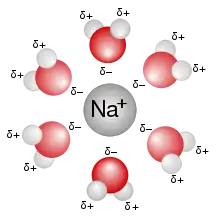

In aqueous solution the water molecules directly attached to the metal ion are said to belong to the first coordination sphere, also known as the first, or primary, solvation shell. The bond between a water molecule and the metal ion is a dative covalent bond, with the oxygen atom donating both electrons to the bond. Each coordinated water molecule may be attached by hydrogen bonds to other water molecules. The latter are said to reside in the second coordination sphere. The second coordination sphere is not a well defined entity for ions with charge 1 or 2. In dilute solutions it merges into the water structure in which there is an irregular network of hydrogen bonds between water molecules.[2] With tripositive ions the high charge on the cation polarizes the water molecules in the first solvation shell to such an extent that they form strong enough hydrogen bonds with molecules in the second shell to form a more stable entity.[3]
The strength of the metal-oxygen bond can be estimated in various ways. The hydration enthalpy, though based indirectly on experimental measurements, is the most reliable measure. The scale of values is based on an arbitrarily chosen zero, but this does not affect differences between the values for two metals. Other measures include the M–O vibration frequency and the M–O bond length. The strength of the M-O bond tends to increase with the charge and decrease as the size of the metal ion increases. In fact there is a very good linear correlation between hydration enthalpy and the ratio of charge squared to ionic radius, z2/r.[4] For ions in solution Shannon's "effective ionic radius" is the measure most often used.[5]
Water molecules in the first and second solvation shells can exchange places. The rate of exchange varies enormously, depending on the metal and its oxidation state. Metal aqua ions are always accompanied in solution by solvated anions, but much less is known about anion solvation than about cation solvation.[6]
Understanding of the nature of aqua ions is helped by having information on the nature of solvated cations in mixed solvents[7] and non-aqueous solvents, such as liquid ammonia, methanol, dimethyl formamide and dimethyl sulfoxide to mention a few.[8]
Occurrence in nature
Aqua ions are present in most natural waters.[9] Na+, K+, Mg2+ and Ca2+ are major constituents of seawater.
Aqua ions in seawater (salinity = 35) Ion Na+ K+ Mg2+ Ca2+ Concentration
(mol kg−1)0.469 0.0102 0.0528 0.0103
Many other aqua ions are present in seawater in concentrations ranging from ppm to ppt.[9] The concentrations of sodium, potassium, magnesium and calcium in blood are similar to those of seawater. Blood also has lower concentrations of essential elements such as iron and zinc. Sports drink is designed to be isotonic and also contains the minerals which are lost in perspiration.
Magnesium and calcium ions are common constituents of domestic water and are responsible for permanent and temporary hardness, respectively. They are often found in mineral water.
Experimental methods
Information obtained on the nature of ions in solution varies with the nature of the experimental method used. Some methods reveal properties of the cation directly, others reveal properties that depend on both cation and anion. Some methods supply information of a static nature, a kind of snapshot of average properties, others give information about the dynamics of the solution.
Nuclear magnetic resonance (NMR)
Ions for which the water-exchange rate is slow on the NMR time-scale give separate peaks for molecules in the first solvation shell and for other water molecules. The solvation number is obtained as a ratio of peak areas. Here it refers to the number of water molecules in the first solvation shell. Molecules in the second solvation shell exchange rapidly with solvent molecules, giving rise to a small change in the chemical shift value of un-coordinated water molecules from that of water itself. The main disadvantage of this method is that it requires fairly concentrated solutions, with the associated risk of ion-pair formation with the anion.
| Ion | Be2+ | Mg2+ | Al3+ | Ga3+ | In3+ | Fe2+ | Co2+ | Ni2+ | Zn2+ | Th4+ |
|---|---|---|---|---|---|---|---|---|---|---|
| Number | 4 | 6 | 6 | 6 | 6 | 6 | 6 | 6 | 6 | 9 |
| Nucleus | 1H 17O | 1H | 1H | 1H 17O | 1H | 17O | 1H | 1H 17O | 1H | 1H |
X-ray diffraction (XRD)
A solution containing an aqua ion does not have the long-range order that would be present in a crystal containing the same ion, but there is short-range order. X-ray diffraction on solutions yields a radial distribution function from which the coordination number of the metal ion and metal-oxygen distance may be derived. With aqua ions of high charge some information is obtained about the second solvation shell.[11][12]
This technique requires the use of relatively concentrated solutions. X-rays are scatted by electrons, so scattering power increases with atomic number. This makes hydrogen atoms all but invisible to X-ray scattering.
Large angle X-ray scattering has been used to characterize the second solvation shell with trivalent ions such as Cr3+ and Rh3+. The second hydration shell of Cr3+ was found to have 13±1 molecules at an average distance of 402±20 pm. This implies that every molecule in the first hydration shell is hydrogen bonded to two molecules in the second shell.[13]
Neutron diffraction
Diffraction by neutrons also give a radial distribution function. In contrast to X-ray diffraction, neutrons are scatted by nuclei and there is no relationship with atomic number.[14] Indeed, use can be made of the fact that different isotopes of the same element can have widely different scattering powers. In a classic experiment, measurements were made on four nickel chloride solutions using the combinations of 58Ni, 60Ni, 35Cl and 37Cl isotopes to yield a very detailed picture of cation and anion solvation.[15] Data for a number of metal salts show some dependence on the salt concentration.
| Salt | LiCl | CaCl2 | NiCl2 | |||||||
|---|---|---|---|---|---|---|---|---|---|---|
| Molality of salt | 27.77 | 9.95 | 3.57 | 4.49 | 2.80 | 1.0 | 3.05 | 0.85 | 0.46 | 0.086 |
| Cation hydration number† | 2.3 (2) | 3.0 (5) | 5.5 (3) | 6.4 (3) | 7.2 (2) | 10.0 (6) | 5.8 (2) | 6.6 (5) | 6.8 (8) | 6.8 (8) |
| θ /deg‡ | 75 (5) | 52 (5) | 40 (5) | 34 (9) | 34 (9) | 38 (9) | 42 (8) | 27 (10) | 17 (10) | 0 (20) |
| Salt | Ni(ClO4)2 | Cu(ClO4)2 | Fe(NO3)3 | NdCl3 | DyCl3 |
|---|---|---|---|---|---|
| Molality of salt | 3.80 | 2.00 | 2.0 | 2.85 | 2.38 |
| Cation hydration number† | 5.8 (2) | 4.9 (3) | 5.0 (2) | 8.5 (2) | 7.4 (5) |
| θ /deg‡ | 42 (8) | 38 (6) | 22 (4) | 24 (4) | 17 (3) |
- †Figures in brackets are standard deviations on the last significant figure of the value.‡ angle between a M-OH2 bond and the plane of the water molecule.
Most of these data refer to concentrated solutions in which there are very few water molecules that are not in the primary hydration spheres of the cation or anion, which may account for some of the variation of solvation number with concentration even if there is no contact ion pairing. The angle θ gives the angle of tilt of the water molecules relative to a plane in the aqua ion. This angle is affected by the hydrogen bonds formed between water molecules in the primary and secondary solvation shells.
The measured solvation number is a time-averaged value for the solution as a whole. When a measured primary solvation number is fractional there are two or more species with integral solvation numbers present in equilibrium with each other. This also applies to solvation numbers that are integral numbers, within experimental error. For example, the solvation number of 5.5 for a lithium chloride solution could be interpreted as being due to presence of two different aqua ions with equal concentrations.
- [Li(H2O)6]+ ⇌ [Li(H2O)5]+ + H2O
Another possibility is that there is interaction between a solvated cation and an anion, forming an ion pair. This is particularly relevant when measurements are made on concentrated salt solutions. For example, a solvation number of 3 for a lithium chloride solution could be interpreted as being due to the equilibrium
- [Li(H2O)4]+ + Cl− ⇌ [Li(H2O)3Cl] + H2O
lying wholly in favour of the ion pair.
Vibrational spectra
Infrared spectra and Raman spectra can be used to measure the M-O stretching frequency in metal aqua ions. Raman spectroscopy is particularly useful because the Raman spectrum of water is weak whereas the infrared spectrum of water is intense. Interpretation of the vibration frequencies is somewhat complicated by the presence, in octahedral and tetrahedral ions, of two vibrations, a symmetric one measured in the Raman spectrum and an anti-symmetric one, measured in the infrared spectrum.
| metal ion | Be2+ | Mg2+ | Mn2+ | Fe2+ | Ni2+ | Cu2+ | Zn2+ | Hg2+ | Al3+ | Ga3+ | In3+ |
|---|---|---|---|---|---|---|---|---|---|---|---|
| wavenumber /cm−1 | 530-543 | 360-365 | 395 | 389 | 405 | 440 | 385-400 | 380 | 520-526 | 475 | 400 |
Although the relationship between vibration frequency and force constant is not simple, the general conclusion that can be taken from these data is that the strength of the M-O bond increases with increasing ionic charge and decreasing ionic size. The M-O stretching frequency of an aqua ion in solution may be compared with its counterpart in a crystal of known structure. If the frequencies are very similar it can be concluded that the coordination number of the metal ion is the same in solution as it is in a compound in the solid state.
Dynamic methods
Data such as conductivity, electrical mobility and diffusion relate to the movement of ions through a solution. When an ion moves through a solution it tends to take both first and second solvation shells with it. Hence solvation numbers measured from dynamic properties tend to be much higher that those obtained from static properties.
Solvation numbers and structures
Alkali metals
Solvation numbers of 3 - 6 have been found for lithium aqua ions. Solvation numbers less than 4 may be the result of the formation of contact ion pairs. The higher solvation numbers may be interpreted in terms of water molecules that approach [Li(H2O)4]+ through a face of the tetrahedron, though molecular dynamic simulations may indicate the existence of an octahedral aqua ion.[20] There are most probably six water molecules in the primary solvation sphere of the sodium ion. For potassium, rubidium and caesium even the primary solvation shell is not well defined.[21]
Alkaline earth metals
| [Be(H2O)4]2+ | [Mg(H2O)6]2+ | Ca2+(aq) | Sr2+(aq) | Ba2+(aq) | |
|---|---|---|---|---|---|
| M-O distance (pm) | 167 | 209 | 242§ | 263§ | 281§ |
| solvation (kJ mol-1) | 2494 | 1921 | 1577 | 1443 | 1305 |
- § Values extrapolated from data for solid-state crystal structures
[Be(H2O)4]2+ has a very well-defined primary solvation shell with a tetrahedral BeO4 core.[22] [Mg(H2O)6]2+ is also a well-characterized species, with an octahedral MgO6 core.[22] The situation for calcium is more complicated. Neutron diffraction data gave a solvation number for calcium chloride, CaCl2, which is strongly dependent on concentration: 10.0±0.6 at 1 mol·dm−3, decreasing to 6.4±0.3 at 2.8 mol·dm−3. The enthalpy of solvation decreases with increasing ionic radius. Various solid hydrates are known with 8-coordination in square antiprism and dodecahedral geometry.[23]
Group 3 metals, lanthanides and actinides
There is now a substantial body of indirect evidence that seven molecules of water are present in the aqua ion of scandium, Sc3+.[24] Yttrium(III) has approximately the same Shannon radius as holmium(III) so Y3+ has very similar properties to those of Ho3+, so its aqua ion is probably 8-coordinate. The lanthanum aqua ion is probably 9-coordinate, as are those of the lighter lanthanides.
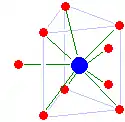
The trivalent lanthanide ions decrease steadily in size from lanthanum to lutetium, an effect known as the lanthanide contraction. Nevertheless, there is strong evidence that the hydration number changes from 9 to 8 at around gadolinium.[25] Structures of aqua ions in the solid state include the 9-coordinate tricapped trigonal prism structure with the lighter lanthanide ions and the 8-coordinate square antiprism structure with the heavier lanthanide ions.[26] Cerium(IV) is 8-coordinate square antiprismatic; europium(II) appears to have coordination number 8, but its structure is not known.[27]
Solvation numbers of 9 or more are believed to apply to the actinide ions in the +3 and +4 oxidation states. This is only known for actinium(III),[28] thorium(IV), uranium(IV), neptunium(IV), plutonium(III) and (IV), americium(III), and curium(III).[27]
Group 4-12 metals
-3D-balls.png.webp)
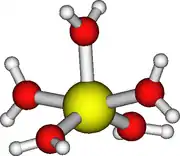
The ions of these metals in the +2 and +3 oxidation states have a solvation number of 6. All have a regular octahedral structure except the aqua ions of chromium(II) and copper(II) which are subject to Jahn-Teller distortion. In the copper case the two axial Cu−O distances are 238 pm, whereas the four equatorial Cu−O distances are 195 pm in the solid state.[30] However, it is unclear whether Cu2+ has a solvation number of 5 or 6 in aqueous solution, with conflicting experimental reports.[27] Silver(I) is probably 4-coordinate, [Ag(H2O)4]+.[31]
A solvation number of 6 with an octahedral structure is well established for zinc(II) and cadmium(II) in dilute solutions. In concentrated solutions the Zn2+ ion may adopt a 4-coordinate, tetrahedral, structure, but the evidence is not conclusive because of the possibility of ion pairing and/or hydrolysis.[32] The solvation number of mercury(II) is most likely to be 6.[33]
The bis aqua structure of the mercury(I) ion, [(H2O)-Hg-Hg-(OH2]+, found in solid compounds, is also found in solution.[34] Another aqua species in which there is a metal-metal bond is the molybdenum(II) species formulated as [(H2O)4Mo≣Mo(H2O)4]4+.[35] Each molybdenum is surrounded by four water molecules in a square-planar arrangement, in a structure similar to that of the known structure of the chloro complex [Mo2Cl8]4−. The presence of a fifth water molecule in the axial position is not ruled out, however.[36]
There are a few divalent and trivalent aqua ions of transition metals in the second and third transition series: molybdenum(III) (usually strongly hydrolyzed), ruthenium(II) and (III), osmium(II), rhodium(III), and iridium(III), all octahedral.[27] Palladium(II) and platinum(II) aqua ions were originally thought to be square planar, but are actually strongly tetragonally elongated octahedral. Silver(I) forms a distorted tetrahedron, gold(I) linear, and gold(III) a distorted octahedron. Distortion occurs for low-coordinate metals with strong covalent tendencies due to the second-order Jahn-Teller effect. With oxidation state 4, however, the only unhydrolyzed species are the square antiprismatic zirconium(IV), [Zr(H2O)8]4+, and hafnium(IV), [Hf(H2O)8]4+, and even they are extremely prone to hydrolysis.[27]
Group 13-16 metals
The aluminium aqua ion, [Al(H2O)6]3+ is very well characterized in solution and the solid state. The AlO6 core has octahedral symmetry, point group Oh. The aqua ions of gallium(III), indium(III) and thallium(III) also have a solvation number of 6. The aqua ion of thallium(I) is often assumed to be 6-coordinate, but this assumption is not based on strong experimental evidence.[37] The Shannon radius of Tl+, at 150 pm, is not very different from that of K+, at 138 pm, so some similarity between Tl+ and K+ chemistry is both expected and observed.[38]
The solvation number of the tin(II) aqua ion, [Sn(H2O)n]2+ is not known with any certainty due to the presence of hydrolysis in the concentrated solutions needed for X-ray scattering measurements.[39] The same is true for the lead(II) aqua ion. With bismuth(III) there is indirect evidence for a solvation number of 9. A nonahydrate is been characterized in the solid state, with a face-capped trigonal prism structure. The Shannon radius for 9-coordinate bismuth (115 pm) is comparable to that of neodymium (116.3 pm) for which a solvation number of 9 is well-established.[40] Calculations for polonium(IV) indicate a solvation number between 8 and 9.[41]
The aqua ions of elements near the metal–nonmetal dividing line are very easily hydrolyzed and cannot be easily studied by experiment. There is some evidence that germanium(II) aqua ions can form in perchloric acid media.[42] Quantum mechanical calculations indicate that the existent borderline cases show extreme distortion of the first coordination sphere due to the high charge density and the stereochemically active lone pairs. For germanium(II), the first shell usually has a solvation number of 6, but numbers 4–7 are also possible and the shell splits into two with differing distances from the central Ge2+.[43] Similar investigations for antimony(III) reveal a solvation number of 8, with the first coordination sphere splitting into two hydration hemispheres with 4 water molecules each.[44]
Although the structures for thallium(I), germanium(II), tin(II), lead(II), and antimony(III) are affected by the lone pairs, this is not so for bismuth(III).[27]
Oxo-aqua-cations
Some elements in oxidation states higher than 3 form stable, aquated, oxo ions. Well known examples are the vanadyl(IV) and uranyl(VI) ions. They can be viewed as particularly stable hydrolysis products in a hypothetical reaction such as
- [V(H2O)6]4+ → [VO(H2O)5]2+ + 2H+
The vanadium has a distorted octahedral environment (point group C4v) of one oxide ion and 5 water molecules.[45] Vanadium(V) is believed to exist as the dioxo-ion [VO2(H2O)4]+ at pH less than 2, but the evidence for this ion depends on the formation of complexes, such as oxalate complexes which have been shown to have the VO+
2 unit, with cis-VO bonds, in the solid state.[46] The chromium(IV) ion [CrO(H2O)5]2+, similar to the vanadium ion has been proposed on the basis of indirect evidence.[47]
The uranyl ion, UO2+
2, has a trans structure. The aqua ion UO2+
2(aq) has been assumed, on the basis of indirect evidence, to have five water molecules in the plane perpendicular to the O-U-O axis in a pentagonal bipyramid structure, point group D5h. However it is also possible that there are 6 water molecules in the equatorial plane, hexagonal bipyramid, point group D6h, as many complexes with this structure are known.[48] The solvation state of the plutonyl ion, PuO2+
2, is not known.
Thermodynamics
The main goal of thermodynamics in this context is to derive estimates of single-ion thermodynamic quantities such as hydration enthalpy and hydration entropy. These quantities relate to the reaction
- Mz+ (gas) + solvent → Mz+ (in solution)
The enthalpy for this reaction is not directly measurable, because all measurements use salt solutions that contain both cation and anion. Most experimental measurements relate to the heat evolved when a salt dissolves in water, which gives the sum of cation and anion solvation enthalpies. Then, by considering the data for different anions with the same cation and different cations with the same anion, single ion values relative to an arbitrary zero, are derived.
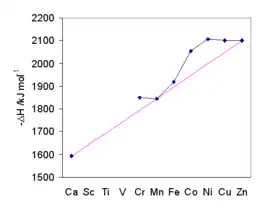
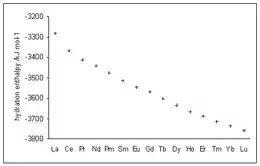
Single ion standard hydration enthalpy /kJ mol−1[49] Li+
-514.6Be2+
-2487.0Na+
-404.6Mg2+
-1922.1Al3+
-4659.7K+
-320.9Ca2+
-1592.4Sc3+
-3960.2... Ga3+
-4684.8Rb+
-296.2Sr2+
-1444.7Y3+
-3620.0... In3+
-4108.7Sn2+
-1554.4Cs+
-263.2Ba2+
-1303.7La3+
-3282.8... Tl3+
-4184.0Pb2+
-1479.9
Other values include Zn2+ -2044.3, Cd2+ -1805.8 and Ag+ -475.3 kJ mol−1.
There is an excellent linear correlation between hydration enthalpy and the ratio of charge squared, z2, to M-O distance, reff.[50]
Values for transition metals are affected by crystal field stabilization. The general trend is shown by the magenta line which passes through Ca2+, Mn2+ and Zn2+, for which there is no stabilization in an octahedral crystal field. Hydration energy increases as size decreases. Crystal field splitting confers extra stability on the aqua ion. The maximum crystal field stabilization energy occurs at Ni2+. The agreement of the hydration enthalpies with predictions provided one basis for the general acceptance of crystal field theory.[51]
The hydration enthalpies of the trivalent lanthanide ions show an increasingly negative values at atomic number increases, in line with the decrease in ionic radius known as the lanthanide contraction.
Single ion hydration entropy can be derived. Values are shown in the following table. The more negative the value, the more there is ordering in forming the aqua ion. It is notable that the heavy alkali metals have rather small entropy values which suggests that both the first and second solvation shells are somewhat indistinct.
Single ion standard hydration entropy at 25 °C /J deg−1 mol−1[52] Li+
-118.8Na+
-87.4Mg2+
-267.8Al3+
-464.4K+
-51.9Ca2+
-209.2... Ga3+
-510.4Rb+
-40.2Sr2+
-205.0... In3+
-426.8Cs+
-36.8Ba2+
-159.0La3+
-368.2...
Hydrolysis of aqua ions
There are two ways of looking at an equilibrium involving hydrolysis of an aqua ion. Considering the dissociation equilibrium
- [M(H2O)n]z+ - H+⇌ [M(H2O)n-1(OH)](z-1)+
the activity of the hydrolysis product, omitting the water molecules, is given by
The alternative is to write the equilibrium as a complexation or substitution reaction
- [M(H2O)n]z+ +OH− ⇌ :[M(H2O)n-1(OH)](z-1)+ + H2O
In which case
The concentration of hydrogen and hydroxide ions are related by the self-ionization of water, Kw = {H+} {OH−} so the two equilibrium constants are related as
In practice the first definition is more useful because equilibrium constants are determined from measurements of hydrogen ion concentrations. In general,
charges are omitted for the sake of generality and activities have been replaced by concentrations. are cumulative hydrolysis constants.
Modeling the hydrolysis reactions that occur in solution is usually based on the determination of equilibrium constants from potentiometric (pH) titration data. The process is far from straightforward for a variety of reasons.[53] Sometimes the species in solution can be precipitated as salts and their structure confirmed by X-ray crystallography. In other cases, precipitated salts bear no relation to what is postulated to be in solution, because a particular crystalline substances may have both low solubility and very low concentration in the solutions.
First hydrolysis constant
The logarithm of hydrolysis constant, K1,-1, for the removal of one proton from an aqua ion
- [M(H2O)n]z+ - H+ ⇌ [M(H2O)n-1(OH)](z-1)+
- [ [M(OH)]{(z-1)+ ] = K1,-1 [Mz+] [H+] −1
shows a linear relationship with the ratio of charge to M-O distance, z/d. Ions fall into four groups. The slope of the straight line is the same for all groups, but the intercept, A, is different.[54]
log K1,-1 = A + 11.0 z/d cation A Mg2+, Ca2+, Sr2+, Ba2+
Al3+, Y3+, La3+−22.0±0.5 Li+, Na+, K+
Be2+, Mn2+, Fe2+, Co2+, Ni2+, Cu2+, Zn2+, Cd2+
Sc3+, Ti3+, V3+, Cr3+, Fe3+, Rh3+, Ga3+, In3+
Ce4+, Th4+, Pa4+, U4+, Np4+, Pu4+,−19.8±1 Ag+, Tl+
Pb2+
Ti3+, Bi3+,−15.9±1 Sn2+, Hg2+, Sn2+, Pd2+ ca. 12
The cations most resistant to hydrolysis for their size and charge are hard pre-transition metal ions or lanthanide ions. The slightly less resistant group includes the transition metal ions. The third group contains mostly soft ions ion of post-transition metals. The ions which show the strongest tendency to hydrolyze for their charge and size are Pd2+, Sn2+ and Hg2+.[54]
The standard enthalpy change for the first hydrolysis step is generally not very different from that of the dissociation of pure water. Consequently, the standard enthalpy change for the substitution reaction
- [M(H2O)n]z+ +OH− ⇌ :[M(H2O)n-1(OH)](z-1)+ + H2O
is close to zero. This is typical of reactions between a hard cation and a hard anion, such as the hydroxide ion.[55] It means that the standard entropy charge is the major contributor to the standard free energy change and hence the equilibrium constant.
The change in ionic charge is responsible for the effect as the aqua ion has a greater ordering effect on the solution than the less highly charged hydroxo complex.
Multiple hydrolysis reactions
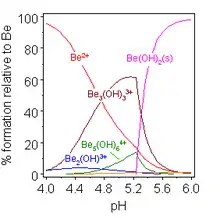
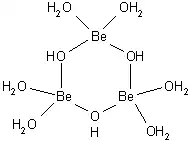
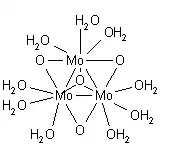
The hydrolysis of beryllium shows many of the characteristics typical of multiple hydrolysis reactions. The concentrations of various species, including polynuclear species with bridging hydroxide ions, change as a function of pH up to the precipitation of an insoluble hydroxide. Beryllium hydrolysis is unusual in that the concentration of [Be(H2O)3(OH)]+ is too low to be measured. Instead a trimer ([Be3(H2O)6(OH3))3+ is formed, whose structure has been confirmed in solid salts. The formation of polynuclear species is driven by the reduction in charge density within the molecule as a whole. The local environment of the beryllium ions approximates to [Be(H2O)2(OH)2]+. The reduction in effective charge releases free energy in the form of a decrease of the entropy of ordering at the charge centers.[56]
Some polynuclear hydrolysis products[57] Species formula cations structure M2(OH)+ Be2+, Mn2+, Co2+, Ni2+
Zn2+, Cd2+, Hg2+, Pb2+single hydroxide bridge between two cations M2(OH)(2z-2)+
2Cu2+, Sn2+
Al3+, Sc3+, Ln3+, Ti3+, Cr3+
Th4+
VO2+, UO2+
2, NpO2+
2, PuO2+
2double hydroxide bridge between two cations M
3(OH)3+
3Be2+, Hg2+ six-membered ring with alternate Mn+ and OH− groups M
3(OH)(3z-4)+
4Sn2+, Pb2+
Al3+, Cr3+, Fe3+, In3+Cube with alternate vertices of Mn+ and OH− groups, one vertex missing M
4(OH)4+
4Mg2+, Co2+, Ni2+, Cd2+, Pb2+ Cube with alternate vertices of Mn+ and OH− groups M
4(OH)8+
8Zr4+, Th4+ Square of Mn+ ions with double hydroxide bridges on each side of the square
The hydrolysis product of aluminium formulated as [Al13O4(OH)24(H2O)12]7+ is very well characterized and may be present in nature in water at pH ca. 5.4.[58]
The overall reaction for the loss of two protons from an aqua ion can be written as
- [M(H2O)n]z+ - 2 H+⇌ [M(H2O)n-2(OH)2](z-2)+
However, the equilibrium constant for the loss of two protons applies equally well to the equilibrium
- [M(H2O)n]z+ - 2 H+⇌ [MO(H2O)n-2](z-2)+ + H2O
because the concentration of water is assumed to be constant. This applies in general: any equilibrium constant is equally valid for a product with an oxide ion as for the product with two hydroxyl ions. The two possibilities can only be distinguished by determining the structure of a salt in the solid state. Oxo bridges tend to occur when the metal oxidation state is high.[59] An example is provided by the molybdenum(IV) complex [Mo3O4(H2O)9]4+ in which there is a triangle of molybdenum atoms joined by σ- bonds with an oxide bridge on each edge of the triangle and a fourth oxide which bridges to all three Mo atoms.[60]
Oxyanions
There are very few oxo-aqua ions of metals in the oxidation state +5 or higher. Rather, the species found in aqueous solution are monomeric and polymeric oxyanions. Oxyanions can be viewed as the end products of hydrolysis, in which there are no water molecules attached to the metal, only oxide ions.
Exchange kinetics
A water molecule in the first solvation shell of an aqua ion may exchange places with a water molecule in the bulk solvent. It is usually assumed that the rate-determining step is a dissociation reaction.
- [M(H2O)n]z+ → [M(H2O)n-1]z+* + H2O
The * symbol signifies that this is the transition state in a chemical reaction. The rate of this reaction is proportional to the concentration of the aqua ion, [A].
- .
The proportionality constant, k, is called a first-order rate constant at temperature T. The unit of the reaction rate for water exchange is usually taken as mol dm−3s−1.
The half-life for this reaction is equal to loge2 / k. This quantity with the dimension of time is useful because it is independent of concentration. The quantity 1/k, also with dimension of time, equal to the half life divided by 0.6932, is known as the residence time or time constant.[61]
The residence time for water exchange varies from about 10−10 s for Cs+ to about 10+10 s (more than 200 y) for Ir3+. It depends on factors such as the size and charge on the ion and, in the case of transition metal ions, crystal field effects. Very fast and very slow reactions are difficult to study. The most information on the kinetics a water exchange comes from systems with a residence time between about 1 μs and 1 s. The enthalpy and entropy of activation, ΔH‡ and ΔS‡ can be obtained by observing the variation of rate constant with temperature.
Kinetic parameters (at 25 °C) for water exchange: divalent ions, M2+ (aq) [62] Be Mg V Cr Mn Fe Co Ni Cu Zn UO2 Residence time (μs) 0.001 2 0.00013 0.0032 0.0316 0.32 0.79 40 0.0005 0.032 1.3 ΔH‡ (kJ mol−1) 43 69 13 34 32 33 43 23 ΔS‡ (J deg−1mol−1) 8 21 -13 12 -13 -17 -22 25
Note the general increase in the residence time from vanadium to nickel, which mirrors the decrease in ion size with increasing atomic number, which is a general trend in the periodic table, though given a specific name only in the case of the lanthanide contraction. The effects of crystal field stabilization energy are superimposed on the periodic trend.
Kinetic parameters (at 25 °C) for water exchange - trivalent ions, M3+ (aq)[62] Al Ti Cr Fe Ga Rh In La residence time (μs) 6.3×106 16 2.0×1012 316 501 3.2×1013 50 0.050 ΔH‡ (kJ mol−1) 11 26 109 37 26 134 17 ΔS‡ (J deg−1mol−1) 117 -63 0 -54 -92 59
Solvent exchange is generally slower for trivalent than for divalent ions, as the higher electrical charge on the cation makes for stronger M-OH2 bonds and, in consequence, higher activation energy for the dissociative reaction step, [M(H2O)n]3+ → [M(H2O)n-1]3+ + H2O. The values in the table show that this is due to both activation enthalpy and entropy factors.[63]
The ion [Al(H2O)6]3+ is relatively inert to substitution reactions because its electrons are effectively in a closed shell electronic configuration, [Ne]3s23p6, making dissociation an energy-expensive reaction. Cr3+, which has an octahedral structure and a d3 electronic configuration is also relatively inert, as are Rh3+ and Ir3+ which have a low-spin d6 configuration.
Formation of complexes
Metal aqua ions are often involved in the formation of complexes. The reaction may be written as
- pMx+(aq) + qLy− → [MpLq](px-qy)+
In reality this is a substitution reaction in which one or more water molecules from the first hydration shell of the metal ion are replaced by ligands, L. The complex is described as an inner-sphere complex. A complex such as [ML](p-q)+ may be described as a contact ion pair.
When the water molecule(s) of the second hydration shell are replaced by ligands, the complex is said to be an outer-sphere complex, or solvent-shared ion pair. The formation of solvent-shared or contact ion pairs is particularly relevant to the determination of solvation numbers of aqua ions by methods that require the use of concentrated solutions of salts, as ion pairing is concentration-dependent. Consider, for example, the formation of the complex [MgCl]+ in solutions of MgCl2. The formation constant K of the complex is about 1 but varies with ionic strength.[64] The concentration of the rather weak complex increases from about 0.1% for a 10mM solution to about 70% for a 1M solution (1M = 1 mol dm−3).
Electrochemistry
The standard electrode potential for the half-cell equilibrium Mz+ + z e− ⇌ M(s) has been measured for all metals except for the heaviest trans-uranium elements.
Standard electrode potentials /V for couples Mz+/M(s)[65][66][67][68] Li+
−3.040Be2+
−1.85Na+
−2.71Mg2+
−2.372Al3+
−1.66K+
−2.931Ca2+
−2.868Sc3+
−2.90... Zn2+
−0.751Ga3+
−0.53Rb+
−2.98Sr2+
−2.899Y3+
−2.37... Cd2+
−0.403In3+
−0.342Sn2+
−0.136Cs+
−3.026Ba2+
−2.912Lu3+
−2.25... Hg2+
−0.854Tl3+
+0.73Pb2+
−0.126Bi3+
+0.16Po4+
+0.76Fr+
−2.9Ra2+
−2.8Lr3+
−1.96La3+
−2.52Ce3+
−2.32Pr3+
−2.34Nd3+
−2.32Pm3+
−2.30Sm3+
−2.28Eu3+
−1.98Gd3+
−2.27Tb3+
−2.27Dy3+
−2.32Ho3+
−2.37Er3+
−2.33Tm3+
−2.30Yb3+
−2.23Ac3+
−2.18Th4+
−1.83Pa4+
−1.46U4+
−1.51Np4+
−1.33Pu4+
−1.80Am3+
−2.06Cm3+
−2.07Bk3+
−2.03Cf3+
−2.01Es3+
−1.99Fm3+
−1.97Md3+
−1.65No3+
−1.20Standard electrode potentials /V for 1st. row transition metal ions[65] Couple Ti V Cr Mn Fe Co Ni Cu M2+ / M −1.63 −1.18 −0.91 −1.18 −0.473 −0.28 −0.228 +0.345 M3+ / M −1.37 −0.87 −0.74 −0.28 −0.06 +0.41 Miscellaneous standard electrode potentials /V[65] Ag+ / Ag Pd2+ / Pd Pt2+ / Pt Zr4+ / Zr Hf4+ / Hf Au3+ / Au Ce4+ / Ce +0.799 +0.915 +1.18 −1.53 −1.70 +1.50 −1.32
As the standard electrode potential is more negative the aqua ion is more difficult to reduce. For example, comparing the potentials for zinc (-0.75 V) with those of iron (Fe(II) -0.47 V, Fe(III) -0.06 V) it is seen that iron ions are more easily reduced than zinc ions. This is the basis for using zinc to provide anodic protection for large structures made of iron or to protect small structures by galvanization.
References
- Burgess, Section 1.2.
- Burgess, p. 20.
- Richens, p. 25.
- Burgess, p. 181.
- Shannon, R.D. (1976). "Revised effective ionic radii and systematic studies of interatomic distances in halides and chalcogenides". Acta Crystallogr. A. 32 (5): 751–767. Bibcode:1976AcCrA..32..751S. doi:10.1107/S0567739476001551.. Richens, Appendix 2.
- Burgess, chapter 11.
- Burgess, Chapter 6.
- Chipperfield, John (1999). Non-Aqueous Solvents. Oxford: OUP. ISBN 978-0-19-850259-3.
- Stumm&Morgan
- Burgess, p. 53.
- Sykes, A.G. (Editor); Johansson, Georg (1992). Structures of Compexes in Solution Derived from X-ray Diffraction Measurements. Advances in Inorganic Chemistry. 39. San Diego: Academic Press. pp. 161–232. ISBN 978-0-12-023639-8.CS1 maint: extra text: authors list (link)
- Ohtaki, H.; Radnai, T. (1993). "Structure and dynamics of hydrated ions". Chem. Rev. 93 (3): 1157–1204. doi:10.1021/cr00019a014.
- Magini, M.; Licheri, G.; Paschina, G.; Piccaluga,G.; Pinna, G. (1988). X-ray diffraction of ions in aqueous solutions : hydration and complex formation. Boca Raton, Fla: CRC Press. ISBN 978-0-8493-6945-2.
- Sykes, A.G. (Editor); Enderby, J.E.; Nielson, G.W. (1989). The Coordination of Metal Aquaions. Advances in Inorganic Chemistry. 34. San Diego: Academic Press. pp. 195–218. doi:10.1016/S0898-8838(08)60017-3. ISBN 978-0-12-023634-3.CS1 maint: extra text: authors list (link)
- Neilson, G.W.; Enderby, J.E. (1983). "The Structure of an Aqueous Solution of Nickel Chloride". Proceedings of the Royal Society A. 390 (1799): 353–371. Bibcode:1983RSPSA.390..353N. doi:10.1098/rspa.1983.0136.
- Enderby, J.E. (1987). "Diffraction Studies of Aqueous Ionic Solutions". In Bellisent-Funel, M-C.; Neilson, G.W. (eds.). The Physics and Chemistry of Aqueous Solutions. NATO ASI Series. Reidel. pp. 129–145. ISBN 978-90-277-2534-9. p. 138.
- Adams, D.M. (1967). Metal-Ligand and Related Vibrations. London: Edward Arnold. p.254.
- Burgess, p. 85.
- Richens, p. 40.
- Richens, p. 126.
- Richens, p. 127.
- Richens, p. 129.
- Richens, section 2.3.
- Richens, p. 176.
- Richens, p. 185.
- Richens, p. 198.
- Persson, Ingmar (2010). "Hydrated metal ions in aqueous solution: How regular are their structures?". Pure and Applied Chemistry. 82 (10): 1901–1917. doi:10.1351/PAC-CON-09-10-22.
- Thierer, Laura M.; Tomson, Neil C. (2017). "The Actinium Aqua Ion: A Century in the Making". ACS Cent. Sci. 3 (3): 153–155. doi:10.1021/acscentsci.7b00074.
- Frank, Patrick; Benfatto, Maurizio; Szilagyi, Robert K.; D'Angelo, Paola; Della Longa, Stefano; Hodgson, Keith O. (2005). "The Solution Structure of [Cu(aq)]2+ and Its Implications for Rack-Induced Bonding in Blue Copper Protein Active Sites". Inorganic Chemistry. 44 (6): 1922–1933. doi:10.1021/ic0400639. PMID 15762718.
- Richens, chapters 4-12
- Richens, p. 521
- Richens, p. 544.
- Richens, p. 555.
- Richens, p 551.
- Finholt, James E.; Leupin, Peter; Sykes, A. Geoffrey (1983). "Kinetics and mechanism of substitution of the quadruply bonded molybdenum(II) aqua dimer with thiocyanate and oxalate". Inorganic Chemistry. 22 (22): 3315–3333. doi:10.1021/ic00164a027.
- Richens, p. 282.
- Richens, section 2.4.
- Greenwood, Norman N.; Earnshaw, Alan (1997). Chemistry of the Elements (2nd ed.). Butterworth-Heinemann. p. 241. ISBN 978-0-08-037941-8..
- Richens, pp152-153.
- Richens, p. 157.
- Ayala, Regla; Martinez, Jose Manuel; Pappalardo, Rafael R.; Muñoz-Paez, A; Marcos, Enrique Sanchez (2007). "Po(IV) Hydration: A Quantum Chemical Study". J. Phys. Chem. B. 2008 (112): 5416–5422. doi:10.1021/jp076032r.
- Pan, Kuan; Fu, Yi-Chang; Huang, Teh-Shoon (December 1964). "Polarographic Behavior of Germanium(II)‐Perchlorate in Perchloric Acid Solutions". Journal of the Chinese Chemical Society. 11 (4): 176–184. doi:10.1002/jccs.196400020.
- Azam, S. S.; Lim, L.; Hofer, T. S.; Randolf, B. R.; Rode, B. M. (2009). "Hydrated Germanium (II): Irregular Structural and Dynamical Properties Revealed by a Quantum Mechanical Charge Field Molecular Dynamics Study". Journal of Computational Chemistry. 31 (2): 278–285. doi:10.1002/jcc.21315.
- https://core.ac.uk/download/pdf/82115185.pdf
- Richens, p. 236
- Richens, p. 240
- Richens, p. 278.
- Richens, p.202.
- Data from Burgess, p. 182.
- Richens, Figure 1.2.
- Orgel, Lesie E. (1966). An introduction to transition-metal chemistry. Ligand field theory (2nd. ed.). London: Methuen. p. 76.
- Burgess, p. 187.
- Baes&Mesmer, chapter 3.
- Baes&Mesmer, p407
- Baes&Mesmer, p 409.
- Baes&Mesmer, section 18.2.
- Baes&Mesmer, Table 18.3.
- Richens, p. 145.
- Baes&Mesmer, p. 420.
- Richens, Figure 6.26, p. 295
-
- Atkins, P.W.; de Paula, J. (2006). Physical Chemistry (8th. ed.). Oxford University Press. ISBN 978-0-19-870072-2. Chapter 22.
- Adapted from Burgess, Tables 11.4 and 11.5
- Burgess, p. 326.
- IUPAC SC-Database A comprehensive database of published data on equilibrium constants of metal complexes and ligands
- Burgess, Table 8.1
- Lide, David R., ed. (2006). CRC Handbook of Chemistry and Physics (87th ed.). Boca Raton, FL: CRC Press. ISBN 0-8493-0487-3.
- Vanýsek, Petr (2011). "Electrochemical Series". In Haynes, William M. (ed.). CRC Handbook of Chemistry and Physics (92nd ed.). CRC Press. pp. 5–80–9. ISBN 978-1-4398-5512-6.
- Standard Electrode Potentials and Temperature Coefficients in Water at 298.15 K, Steven G. Bratsch (NIST)
Bibliography
- Baes, C.F.; Mesmer, R.E. (1986) [1976]. The Hydrolysis of Cations. Malabar, FL: Robert E. Krieger. ISBN 978-0-89874-892-5.
- Burgess, John (1978). Metal Ions in Solution. Chichester: Ellis Horwood. ISBN 978-0-85312-027-8.
- Richens, David. T. (1997). The Chemistry of Aqua Ions. Wiley. ISBN 978-0-471-97058-3.
- Stumm, Werner; Morgan, James J. (1995). Aquatic Chemistry - Chemical Equilibria and Rates in Natural Waters (3rd. ed.). Wiley-Blackwell. ISBN 978-0-471-51185-4.
- Schweitzer, George K.; Pesterfield, Lester L. (2010). The Aqueous Chemistry of the Elements. Oxford: OUP. ISBN 978-0-19-539335-4.
Further reading
- H. L. Friedman, F. Franks, Aqueous Solutions of Simple Electrolytes, Springer; reprint of the 1973 edition, 2012 ISBN 1468429574
